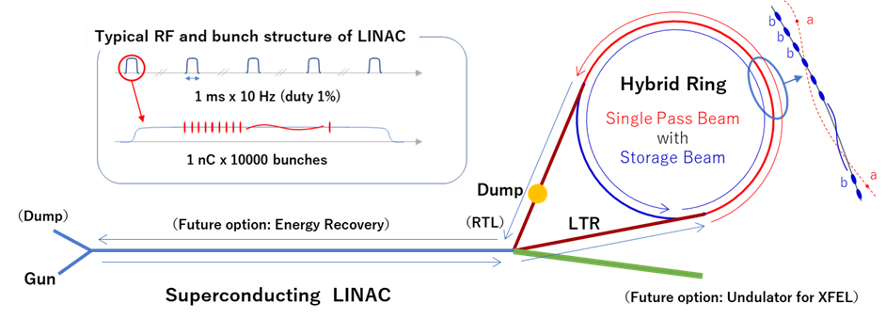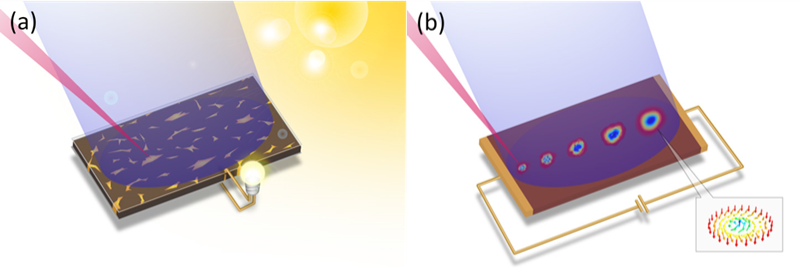This article is an English translation of a KEK press release for the article published in Journal of Synchrotron Radiation.
K. Harada et al., Conceptual design of the Hybrid Ring with superconducting linac, J. Synchrotron Rad., 29, 118 - 134 (2022). https://doi.org/10.1107/S1600577521012753
A new idea for epochal synchrotron radiation facility is proposed at the Photon Factory jointly operated by the Institute of Materials Structure Science and the Accelerator Laboratory of the High Energy Accelerator Research Organization (KEK). The new facility called the Hybrid Ring is the advanced storage ring light source combined with a long pulsed superconducting linear accelerator.
The Photon Factory (PF) was the first dedicated synchrotron radiation facility in Japan with a wide range of photon energy from VSX to X-rays. From its first beam in 1982, PF widely supports both basic science and its application of the researchers from universities, national organizations, and private companies. Now, KEK aims to construct a successor facility to the Photon Factory by the early 2030s that is the 50th anniversary of the first beam. New design for the light source facility suitable for a world-class accelerator research institute is underway.
A research group led by Associate Professor Kentaro Harada and Professor Yukinori Kobayashi at the Accelerator Division 6 of the Accelerator Laboratory and Professor Nobumasa Funamori at the Photon Factory of the Institute of Materials Structure Science have developed a new concept of a synchrotron radiation facility called the Hybrid Ring. The Hybrid Ring can not only promote conventional synchrotron radiation user experiments but also develop a new type of user experiment by simultaneous use of two synchrotron radiation beams. These features are expected to make further contributions to a wider range of scientific and technological fields.
Synchrotron radiation from relativistic electron accelerators was discovered in the 1940s and firstly used in the materials science in the 1960s. Later, in the late 1990s and 2000s, many “third-generation” light source facilities were widely constructed. The numbers of user experiments are drastically increased due to the high performance and user-friendliness of these facilities. Today, synchrotron radiation light sources become an indispensable research infrastructure all over the world not only in material science, but also in all fields, for example, including life science, space and earth science, and archaeology.
The performances of light source accelerators and experimental beam lines are improving day by day. For the latest 4th generation light sources, the significant improvement is mainly focused to the brightness and spatial coherence (*1) of synchrotron radiation, especially in the X-ray region. However, to achieve such performance, many restrictions are imposed on the design and operation of accelerators that results in a loss of flexibility. For example, the photons from vertical superconducting wigglers (*2) and isolated large charge bunch (*3) are actively utilized in the Photon Factory, but these may be incompatible with the design policy and performance improvement of the 4th generation light sources. Therefore, it may be difficult to maintain these unique technologies in the latest synchrotron radiation facilities.
To realize versatility, prominent feature, and flexibility in one facility, it is necessary to introduce a new idea to the light source design. The Hybrid Ring, our solution, is the combination of multi-purpose and easy-to use conventional storage ring with most advanced and flexible long pulsed superconducting linear accelerator (*4) as an injector (Fig. 1). In the Hybrid Ring, in addition to the conventional synchrotron radiation from the stored beam, at the part of the ring (about 2/3 of whole circumference), synchrotron radiation from a single pass beam directly from the injector LINAC can be available. The single pass beam has most advanced parameters as ultra-low emittance and/or ultra-short pulse with flexibility in beam size, pulse width, and beam repetition rate that are difficult to change in the stored beam. Simultaneous use of single pass beam with stored beam, user experiment with two synchrotron radiation beams can be realized.

The long-pulse superconducting linear accelerator has been developed in KEK with collaboration with overseas research institutes for the ILC project (*5). It can efficiently output a high-current beam. Pulsed RF (electromagnetic field used for acceleration) operation can minimize the heat load. With long pulse length, large number of electron bunches can be accelerated in a single macro pulse and the average current can be drastically increased. It is already under operation in advanced free-electron laser facilities overseas, where it stably generates electron beams with much higher performance than storage rings. In order to transport the electron beam from the linear accelerator through the ring without deterioration of beam parameters, the lattice of beam transport and storage ring needs to be optimized. Adopting partially isochronizing low emittance lattice with small dispersion and large curvature radius in bending magnets as recent light sources, the deterioration of emittance and bunch length can be suppressed.
Simultaneous use of two synchrotron radiation beams in the Hybrid Ring is useful, for example, for the study of artificial photosynthesis, solar cells, and photocatalysts, which are promising for the realization of a sustainable society. The slow changes on the whole sample can be measured by the conventional synchrotron radiation from a stored beam and the local fast changes at interfaces and phase boundaries simultaneously by the ultra-high performance synchrotron radiation from a single-pass beam. The nature of the photochemical reactions (Fig. 2(a)) is expected to be revealed. It will also enable us to make a new attempt to use two synchrotron radiation beams as pump-probe. Magnetic skyrmions (*6), a promising next generation spintronics device, are generated by short-pulsed synchrotron radiation of a single-pass beam and measured by conventional synchrotron radiation (Fig. 2(b)). The fundamental mechanism of the generation and control of magnetic skyrmions can be elucidated.

The Photon Factory has been constantly producing significant results and contribution to Nobel Prize research in academia and product development in commercial industry. A new era of synchrotron radiation science will be opened up by realizing the Hybrid Ring that enables simultaneous use of two synchrotron radiation beams while maintaining and developing the excellent conventional technologies and devices. The research group plans to proceed with the detailed design of the Hybrid Ring in order to further contribute to a wide range of scientific and technological fields.
*1. Brightness and spatial coherence
The brightness is the phase space density of photons. It shows concentration of photons in position and direction. Coherence refers to the fluctuation of wavefront. Light with a high brightness has high coherence and can be focused to a small spot size without large divergence. Such photon beam can be focused in a small area on a sample. The coherence itself can be used for experiments.
*2. Vertical superconducting wiggler
The vertical superconducting wiggler is an insertion device installed in the number fourteen straight section of the PF ring that generates high energy X-rays by strong superconducting vertical bending magnet. Since the generated light has a vertical spread, the beamline optics and detectors can be placed horizontally on one large surface plate. Compared to a vertical setup of optical component, this configuration improves stability and accuracy, and as a result, enables high-performance measurements. In fact, the separated-type interferometer installed in the BL-14C of the PF has the best performance in the world in terms of wide-field and high-sensitivity. For the performance of the accelerator, however, the strong vertical bending magnet cause emittance growth in both horizontal and vertical direction. In the present PF ring, this is not a concern, but in the latest 4th generation light sources, it may be a major problem that prevent such device installation.
*3. Isolated large charge bunch
In ordinary visible photography, an image of certain moment for moving object can be captured by increasing the shutter speed and/or using a flashlight. For the synchrotron radiation, single or isolated high charge electron bunch enables such time resolved measurement. The PF-AR always operates with only one bunch. For the PF ring, the hybrid mode operation has isolated high charge bunch. In bunch filling pattern for the hybrid mode, there are about 300ns spacing without electron bunch trains and only one high charge bunch is at the center of this dark time. For the accelerator technology, the accumulation of a large charge bunch requires countermeasures against the beam instability and heat treatment due to the strong wake field. The latest 4th generation light sources, however, require a narrow beam duct to keep strong focusing magnetic field. The narrower the vacuum duct is, the stronger the interaction with the electron beam is. Thus the accumulation of large charge bunch is more difficult for the latest light sources than for the case with larger diameter vacuum duct of present PF and PF-AR.
*4. Long pulse superconducting linear accelerator
In a superconducting linear accelerator, the accelerating cavity is installed to liquid and depressurized helium at 2 K to maintain superconductivity with high electric and magnetic field. For pulsed mode operation, the radio frequency (RF) electric field is introduced to accelerating structure only for very short time with interval. The electrons can be accelerated only when the cavity is filled with RF field. The repetition rate and pulse width of RF pulse vary depending on the facility. For example, in the case of normal-conducting accelerators, the pulse repetition rate is generally 10 Hz and the pulse width is about 1 μs due to the heat load. Usually only one bunch of electrons can be accelerated in one RF pulse. On the other hand, in the case of a superconducting accelerator, continuous mode operation that RF is always filled in cavity can be thermally possible. For such operation, however, the required capacity of the refrigerator and the electric power consumption become huge. For pulsed mode superconducting accelerator, pulse width become longer and multi bunch acceleration can be possible. Using such long pulse superconducting linear accelerator, high output current can be realized very efficiently. For example, in the case of EuroXFEL, the RF pulse repetition rate is 10 Hz, the same as that of normal conduction, but the pulse width is long as about 1 ms. In this long RF macropulse, 2700 electron bunches can be accelerated. The number of bunches can directly increase the output current. The long pulse superconducting linear accelerator can provide 1000 to 10000 times higher output current than the normal conducting case.
*5. ILC Project
The International Linear Collider (ILC) is a future accelerator project that is currently developed and promoted by the international collaboration of researchers from Japan, the United States, Europe, and other countries. The ILC is ultra-high energy electron and positron collider using long pulse superconducting accelerator technology.
*6. Magnetic skyrmion
Magnetic skyrmion is a quasiparticle with a magnetic vortex structure. The magnetic skyrmions behaves as stable particles and can be moved efficiently by a small electric current. Their application to the next generation recording media seems to be promising for high density and low power consumption.